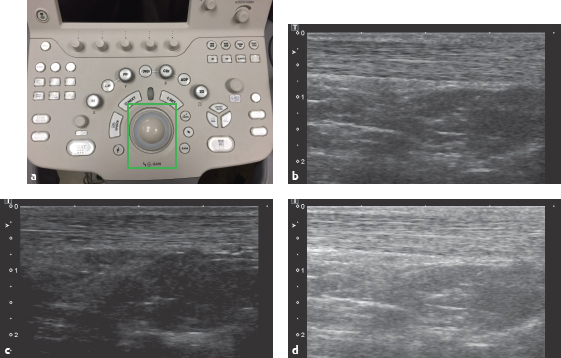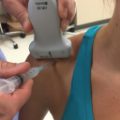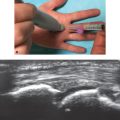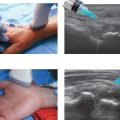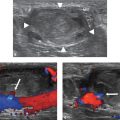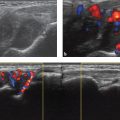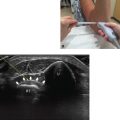2 Image Optimization in Musculoskeletal Ultrasound Imaging
♦ Transducer
• Within an ultrasound transducer is a piezoelectric element (lead zirconate titanate). Piezoelectric elements convert electric voltage into ultrasound pulses and convert returning echoes back into electric voltages. Several such elements are present in linear and curved transducers.
• The three basic transducer shapes are shown in Fig. 2.1: curved, linear, and phased array.
• For upper extremity scanning, the linear transducer is most commonly used.
♦ Frame and Frame Rate
• One pulse of ultrasound travels through the tissue, creating echoes along the way that eventually generate one scan line. A series of such scan lines across the screen results in one frame. The number of such frames in one second is called frame rate, measured in Hertz and displayed on the screen.
• The frame rate is so fast that a human eye sees it as a real-time image (similar to a movie film projecting individual images at a fast rate).
• The frame rate is not directly controlled by the user. It is indirectly affected by the other factors discussed in the following sections.
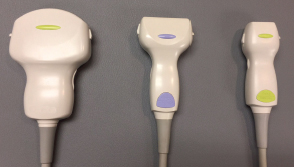
Fig. 2.1 The three basic transducer shapes: curved, linear, and phased array.
♦ Depth
• Depth determines how deeply within the body the structure needs to be visualized (Fig. 2.2a).
• Depth is displayed on the screen as centimeters along the image. In upper extremity scanning, a depth of 1 to 4 cm is typically selected.
• A shallow depth makes the image appear large, and vice versa. Depth should be adjusted so the structure appears large enough but the entire area of interest is visible (Fig. 2.2b-d).
• When deeper structures are scanned, the sound waves need to travel and return from a farther distance; this results in a lower frame rate.
• The user can adjust depth with the depth knob.
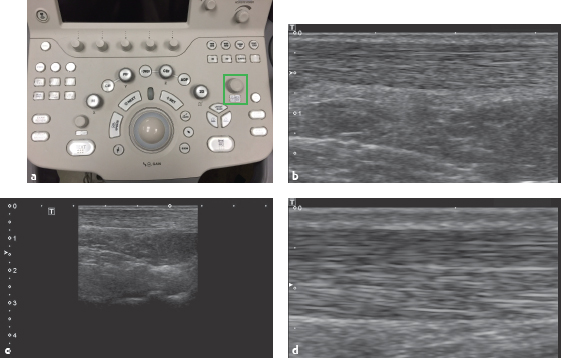
Fig. 2.2 (a) The depth knob is turned to adjust the depth setting. (b) Optimum depth. The tendon appears the correct size. (c) Depth setting too deep. The tendon appears too small. (d) Depth setting too shallow. The tendon appears too big with no perspective of surrounding structures.
♦ Attenuation
• As sound travels through the tissues, it is reflected, scattered, and absorbed. These phenomena result in weakening (degradation) of the sound as it travels deeper through the tissue (similar to listening to an audio speaker; the farther the listener is from the speaker, the weaker the sound). This is called attenuation.
• Attenuation results in the ultrasound image appearing darker in the deeper part of the image.
• Attenuation cannot be controlled by the user (however, see the Gain and Time Gain Compensation sections for options for compensation).
♦ Power
• Power is the rate at which an acoustic energy flows across a surface, measured in Watts.
• Excessive use of acoustic power has a potential for tissue biological effects. Hence the U.S. Food and Drug Administration (FDA) and American Institute of Ultrasound in Medicine (AIUM) have set guidelines.
• The “as low as reasonably achievable” (ALARA) principle is followed: A medical indication is required, and minimum output and exposure time must be used in diagnostic examinations so exposure and risk are minimized.
• Power can be adjusted by the user but typically is not. It is usually preset.
♦ Gain
• Similar to using an amplifier for an audio speaker, ultrasound beam attenuation can be compensated for; a weak sound received by the transducer can be amplified. Gain control determines how much amplification occurs.
• Increasing gain makes the image brighter.
• The gain knob is adjusted to increase or decrease gain (Fig. 2.3). Gain control should be adjusted to an appropriate level to achieve a good diagnostic image. Gain set too high will result in a bright, washed-out image. Gain set too low will result in a dark image.
